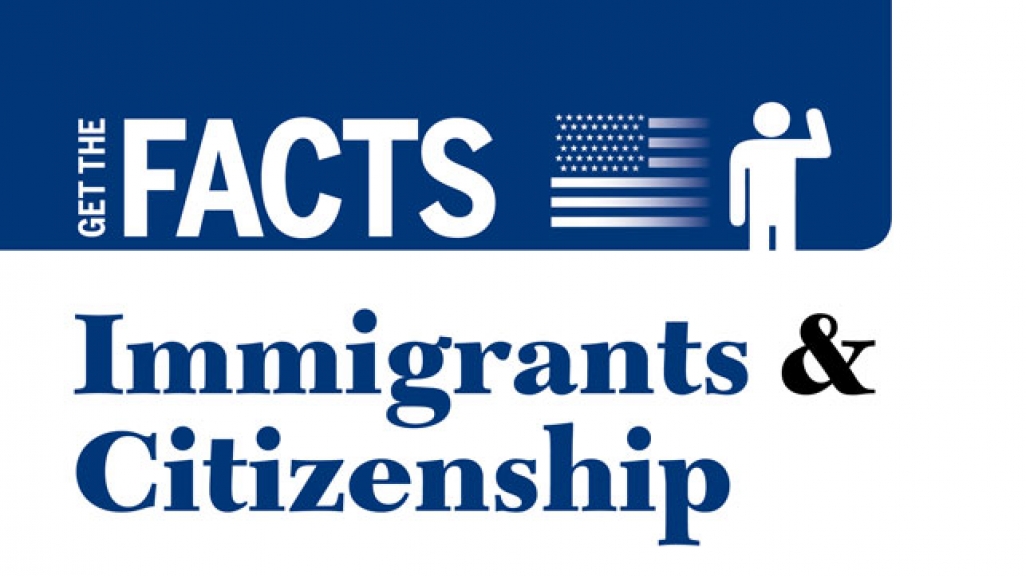Get the Facts: Five Ways Naturalized Citizens Contribute to the U.S. Economy
Get the Facts: Five Ways Naturalized Citizens Contribute to the U.S. Economy
If more immigrants became citizens, the United States would expand its GDP and job market.
Immigrants contribute to the economic vibrancy of communities across the country—contributions that could be dramatically expanded if more immigrants became naturalized citizens. In 2012, nearly 8.8 million immigrants were eligible to naturalize, but due to barriers such as the prohibitive cost of the application and lack of information around eligibility and how to apply, only 757,000 legal permanent residents (LPRs) were naturalized that year. [1] This fact sheet—the eleventh in our series on immigrants and the economy—details five ways naturalized citizens bolster the U.S. economy, and why comprehensive immigration reform that includes a pathway to citizenship will maximize immigrants’ contributions nationwide.
- Download a PDF of the fact sheet.
- Access AS/COA’s Get the Facts series at: www.as-coa.org/immigration-facts.
1. Naturalized citizens earn higher incomes, leading to increased purchasing power and contributions to GDP.
- Immigrants would see a 25.1 percent increase in their income when granted legal status and ultimately citizenship—with 40 percent of that gain coming from naturalization alone—generating more taxable income and greater purchasing power. [2]
- If the U.S. naturalized 1 million immigrants—just 4 percent more than were naturalized during the peak year of 2008—the cumulative increase in their earnings over a 10-year period would amount to between $21.1 billion and $29.4 billion, providing a much-needed injection of capital into the still-recovering U.S. economy. [3]
- Should half of all eligible LPRs become naturalized within 10 years, at minimum, U.S. GDP would increase $1.17 for every $1 increase in their total annual earnings. If 1.5 million immigrants were naturalized every year over the same period, it would translate into a GDP increase of between $26 billion and $52 billion. [4]
2. Naturalized immigrants are essential to keeping Social Security and other programs such as Medicare solvent, as well as supporting the local, state, and national tax base in the United States.
- As baby boomers age, the financial stability of the Medicare Hospital Insurance Trust Fund is projected to become insolvent by 2026. If undocumented immigrants eligible for legalization under the proposed 2013 Senate Bill S. 744 were naturalized, they would contribute $202 billion more into the Medicare system than they would receive in benefits over the next 20 years. They would contribute $9 billion if they were provided only legal status without a path to citizenship. [5]
- Had undocumented immigrants been granted legal status and citizenship in 2013, they would have contributed $184 billion in tax revenue over the next 10 years—$116 billion federally and $68 billion to state and local governments. If they were to be granted citizenship in 2018, naturalized immigrants would contribute $144 billion in taxes, with $91 billion going to the federal government and $53 billion to state and local governments. [6]
3. Through naturalization, immigrants are more likely to integrate into their local communities through educational advances, home ownership, and an increased standard of living.
- In 2012, 58 percent of naturalized citizens ages 25 and older had at least some post-secondary education. This is on par with the 61 percent of U.S.-born citizens in the same age group, and almost twice as much as non-citizens (37 percent). Naturalized citizens are also more likely to complete high school than non-citizens (79 percent vs. 59 percent). [7]
- Naturalized citizens are almost twice as likely as non-citizens to be homeowners (65 percent vs. 34 percent), which is similar to the 66 percent of native-born Americans who own homes. [8]
- Attaining citizenship improves one’s standard of living. Both naturalized immigrants and native-born citizens make at least $10,000 more in income on average than non-citizen immigrants and are at least half as likely to live below the poverty line. [9]
4. Naturalized citizens help create jobs for U.S.-born citizens.
- In California, naturalized citizens are more likely than non-citizens to be banked—89.8 percent of naturalized citizens were banked as opposed to 61 percent of non-citizens who are eligible for naturalization. Being banked allows for access to credit and financial services that help naturalized citizens start small businesses and create jobs for U.S.-born workers. [10]
- If undocumented immigrants had been granted legal status in 2013, and citizenship five years later, 159,000 jobs would have been created per year over the next 10 years. If they had been granted legal status and citizenship in 2013, 203,000 jobs would have been created per year in the same time period. [11]
- In 2011, immigrants—including naturalized citizens—created jobs by employing one in 10 U.S. workers and starting 28 percent of new businesses in the country. [12]
5. An earned pathway to citizenship is crucial to any comprehensive immigration reform legislation, and enjoys broad support among a majority of Americans across party lines.
- If reform was enacted that allowed for naturalization of the country’s 11 million undocumented immigrants after five years, GDP would increase by $1.1 trillion and total income for all Americans would grow by $618 billion over 10 years. [13]
- Had immigrants become eligible for citizenship through comprehensive immigration reform in 2013, the gains to the economy—measured in GDP, incomes for all Americans, jobs created and tax contributions—would be nearly 70 percent greater by 2022 than if only legalization was offered. [14]
- According to a June 2014 poll by the Public Religion Research Institute and The Brookings Institution, 62 percent of Americans support a pathway to citizenship requirements like background checks and payment of fines and back taxes as part of comprehensive reform. This includes 70 percent of Democrats, 61 percent of independents, and 51 percent of Republicans. [15]
This fact sheet is a product of the AS/COA Immigration and Integration Initiative, which promotes positive dialogue around the economic contributions of immigrants across the United States. It was produced by policy associates Leani García and Rebecca Bintrim, in collaboration with Adam Wolsky and policy managers Richard André and Kate Brick. For media inquiries or to speak with an expert on this topic, please contact Adriana La Rotta in our communications office at: alarotta@as-coa.org.
1. The most recent figures provided by the Department of Homeland Security are from 2012.
2. Robert Lynch and Patrick Oakford, “The Economic Effects of Granting Legal Status and Citizenship to Undocumented Immigrants,” Center for American Progress, 2013, p.9.
3. Manuel Pastor and Justin Scoggins, “Citizen Gain: The Economic Benefits of Naturalization for Immigrants and the Economy,” Center for the Study of Immigrant Integration, University of Southern California, 2012, p.19.
4. Ibid, p.20.
5. Patrick Oakford and Robert Lynch, “How Will Immigration Reform Impact the Medicare Trust Fund?” Center for American Progress, February 27, 2014, pp.1-4.
6. Pastor and Scoggins, “Citizen Gain: The Economic Benefits of Naturalization for Immigrants and the Economy,” Center for the Study of Immigrant Integration, University of Southern California, p.2.
7. Gregory Auclair and Jeanne Batalova, “Naturalization Trends in the United States,” Migration Policy Institute, 2013.
8. Ibid.
9. Pastor and Scoggins, “Citizen Gain: The Economic Benefits of Naturalization for Immigrants and the Economy,” p.7.
10. “Latino Financial Access and Inclusion in California,” National Council of La Raza, 2013, p.15.
11. Lynch and Oakford, “The Economic Effects of Granting Legal Status and Citizenship to Undocumented Immigrants,” Center for American Progress, p.2.
12. Robert H. Fairlie, “Open for Business: How Immigrants are Driving Small Business Creation in the United States,” Partnership for a New American Economy,” 2012, pp.7, 27.
13. Lynch and Oakford, “The Economic Effects of Granting Legal Status and Citizenship to Undocumented mmigrants,” Center for American Progress, p.2.
14. Ibid, p.8.
15. Robert P. Jones et al, “What Americans Want From Immigration Reform in 2014: Findings from the PRRI/Brookings Religion, Values, and Immigration Reform Survey, Panel Call Back,” Public Religion Research Institute and The Brookings Institution, 2014, pp.18-19.









